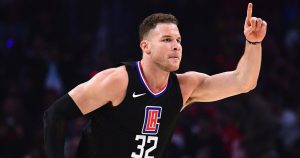by Alvin Halimwidjaya

The first thing you notice about Blake Griffin is how he seems to fly in the air. The star forward’s highlight reel is filled with casual in-game windmill dunks, whether on his own or off an alley-oop, while he has turned center Timofey Mozgov’s last name into a verb for what he does to his victims at the end of a pick and roll. Even Kia’s string of successful commercials has him in a fictitious realm in the clouds, as if to say that Griffin is a man not meant for gravity. However, he’s turned himself into more than that, becoming a triple double threat with the court vision of a guard and a disturbingly refined three-point shot; now, as he faces a change of scenery, it’s time to see if he can prove his worth as a top-15 player in the NBA.
On Monday, Jan. 29, Griffin was traded from the Los Angeles Clippers to the Detroit Pistons along with big men Brice Johnson and Willie Reed for Avery Bradley, Tobias Harris and Boban Marjanovic, a future first-round pick and a future second-round pick. The Clippers seem to be ready to rebuild, and they have a couple nice pieces in Bradley’s “3 and D” mold and the sharpshooting Harris, despite head coach Doc Rivers’ odd propensity for trading almost exclusively for players on his former Celtics team. However, the focus should be on if Blake Griffin can handle the added pressure Motown is going to bring.
Griffin will undoubtedly be facing easier competition in the Eastern Conference; with a dearth of elite big men facing up against him, Griffin’s production should see a sizable increase. Pistons center Andre Drummond provides less than former frontcourt mate Deandre Jordan, but is still an incredible rebounder and fits the same mold, allowing Griffin to handle the ball more and not deal with the dirty work in the paint. However, Blake is used to the spotlights and the headlines; as he leaves the glamour of LA, it remains to be seen whether Griffin can handle the lower attendance rates and the more apathetic attitude fans in the Motor City have developed.
Not to mention, Griffin still has questions to answer on the court; his injury history remains a problem, as he hasn’t played 70 games in a season in quite a while. In addition, his fourth quarter production has been a point of concern the past few years, which begs the question: will he really be able to lead a team to significant success when it counts?
With the Pistons, Griffin has the perfect opportunity to prove to the league that he belongs in the elite superstar category in the NBA. A run to the playoffs, even if it’s just the seventh or the eighth spot, should be well within reach. From there, it’s up to whether the promising frontcourt of Griffin and Drummond can lead the Pistons to real playoff success.




































































































































































































